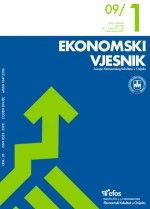Otkrivanje prostorne autokorelacije pomoću lokalnih indikatora
Revealing a spatial autocorrelation with local indicators
Author(s): Dražen BarkovićSubject(s): Economy, Geography, Regional studies, Geomatics, Socio-Economic Research
Published by: Sveučilište Josipa Jurja Strossmayera u Osijeku, Ekonomski fakultet u Osijeku
Keywords: spatial autocorrelation; local Moran coefficient; global Moran coefficient; Getis-Ord statistics; „hot spots“ i „cold spots“;
Summary/Abstract: Spatial autocorrelation may be defined as the relationship among values of a single variable that comes from the geographic arrangement of the areas in which these values occur. It measures the similarity of objects within an area, the degree to which a spatial phenomenon is correlated to itself in space, the level of interdependence between the variables, the nature and strength of the interdependence, i.e. spatial autocorrelation is an assessment of the correlation of a variable in reference to spatial location of the variable. Assess if the values are interrelated, and if so is there a spatial pattern to the correlation, i.e. is there spatial autocorrelation. Spatial autocorrelation tools test whether the observed value of a variable at one locality is independent of values of the variable at neighboring localities. Spatial autocorrelation may be classified as either positive or negative. Positive spatial autocorrelation has all similar values appearing together, while negative spatial autocorrelation has dissimilar values appearing in close association. map. When no statistically significant spatial autocorrelation exists, the pattern of spatial distribution is considered random. Spatial autocorrelation can be measured on local and global level. This study presents both of these measures and illustrates them on a practical example.
- Issue Year: 22/2009
- Issue No: 1
- Page Range: 23-32
- Page Count: 10
- Language: Croatian

